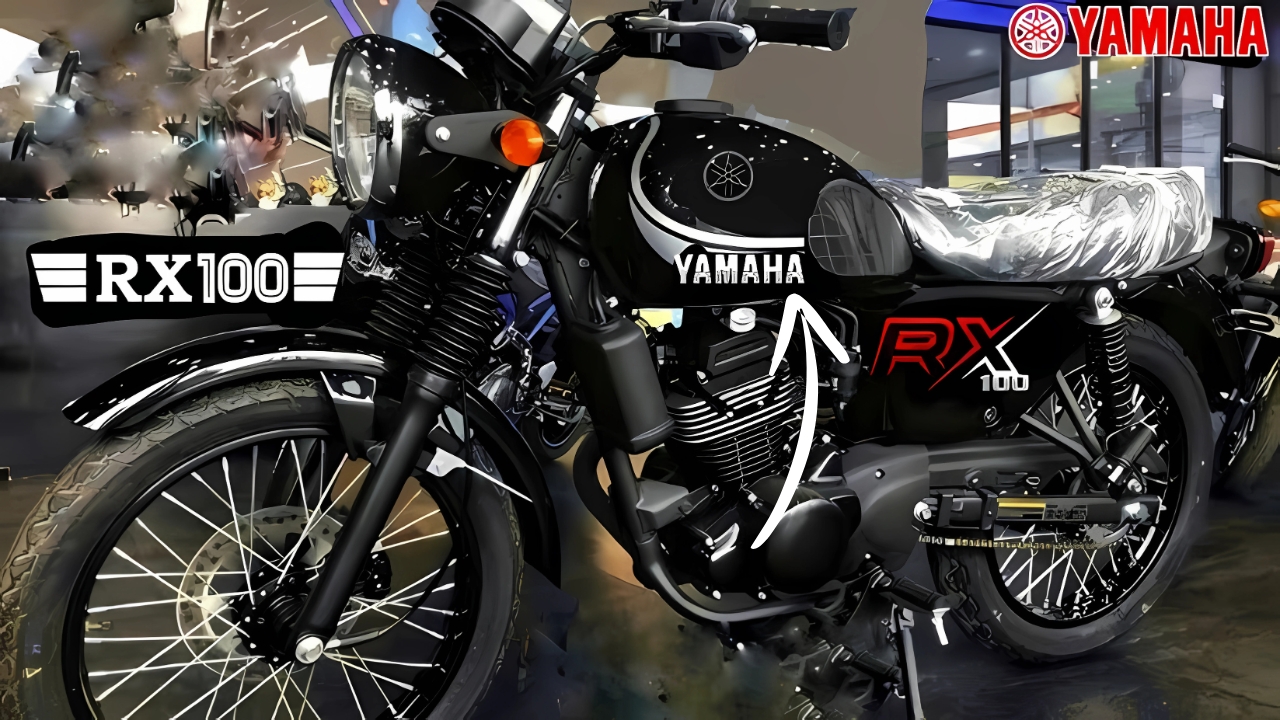Yamaha stunned fans by stealth-launching the RX100 on January 15, 2025, at a glitzy Delhi event streamed globally. Priced between ₹1.4 lakh (base) and ₹1.6 lakh (Stealth Edition), it undercuts retro rivals like the Royal Enfield Classic 350 while offering modern thrills. Bookings opened immediately, with deliveries starting in March 2025. Dealers report 18-month waiting lists, proving nostalgia sells—even in the EV era.
The 2025 RX100 retains its iconic teardrop fuel tank and chrome-finished exhaust but adds LED headlamps with halo DRLs and 17-inch spoked alloy wheels. The Stealth Edition flaunts matte-black paint, red brake calipers, and a retro-modern split seat. At 1,980 mm long and 795 mm seat height, it’s slightly taller than the 1996 model but retains its signature slim profile.Inside, the cockpit merges old-school vibes with smart tech: a semi-digital console pairs an analog speedometer with a Bluetooth-enabled display for navigation. Practical touches include a USB-C port under the tank and rust-resistant fasteners for monsoon durability.
Built on a lightweight diamond frame, the RX100’s specs bridge eras:
- : 149cc, 4-stroke, air-cooled
- : 14.2 bhp @ 7,500 RPM
- : 13.5 Nm @ 6,000 RPM
- : 129 kg (lighter than Royal Enfield Hunter 350)
- : 12 liters (500 km range)
The 5-speed gearbox ensures smooth shifts, while the slipper clutch minimizes rear-wheel hop during aggressive downshifts.
Gone are the drum brakes—the 2025 model packs dual-channel ABS and a 270mm front disc. Higher trims add traction control and LED cornering lights, a first in its segment. Though unrated by Bharat NCAP, Yamaha claims the RX100’s high-tensile steel frame meets global crash standards.
The RX100’s new 4-stroke engine mimics the original’s throaty growl via a tuned exhaust, delivering 0–60 km/h in 5.8 seconds (faster than the Honda CB200X). The 4-valve setup ensures crisp throttle response, while a low-inertia crankshaft lets it rev freely. Highway cruising peaks at 110 km/h, though vibrations creep in post-90 km/h—a nod to its raw heritage.
- : Track rides, geofence alerts, and service reminders via smartphone.
- : RFID key fob with proximity unlock.
- : Caps RPM at 6,000 for 50 kmpl fuel efficiency.
Missing? A TFT screen—Yamaha insists the RX100 is about “pure riding,” not Netflix on wheels.
ARAI claims 50 kmpl, but real-world figures dip to 40–45 kmpl in cities. The 12-liter tank still delivers 500 km highway runs, while maintenance costs (₹3,000/year) undercut most 150cc bikes. The 3.5L utility box under the seat fits a raincoat or toolkit—perfect for impromptu adventures.
- : ₹1.4 lakh (spoked wheels, single-channel ABS)
- : ₹1.6 lakh (dual ABS, Bluetooth, premium paint)
Yamaha offers ₹99/day EMI plans, targeting millennials who missed the original RX100 era.
Launched in 1985, the RX100 became India’s first “sports commuter,” famed for its 11 bhp two-stroke engine and addictive exhaust note. Discontinued in 1996 due to emission norms, it gained cult status, with used models selling for ₹3 lakh. The 2025 reboot honors this legacy while embracing BS6-2 norms—proving classics never die, they evolve.
: Can it handle Ladakh highways?
A: Yes, but stick to sub-3,000m altitudes. The air-cooled engine struggles in thin air.
A: Purists demanded a kick starter—it’s standard, with an optional push-button add-on
A: Shift below 4,000 RPM and use Eco Mode—rewards you with 50+ kmpl
A: Projected at 70% after 5 years—higher than most ICE bikes.
The 2025 Yamaha RX100 isn’t perfect—it’s vibey at high speeds, lacks a sixth gear, and the seat could be plusher. But as a ₹1.4 lakh time machine blending ’90s nostalgia with 2025 tech, it’s irresistible. For every rider who grew up dreaming of an RX100, Yamaha just granted your wish.Visit your nearest Yamaha showroom—if you’re ready to wait till 2026.
